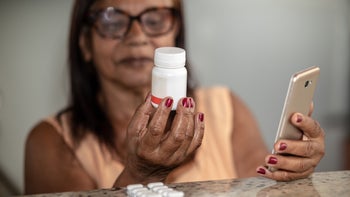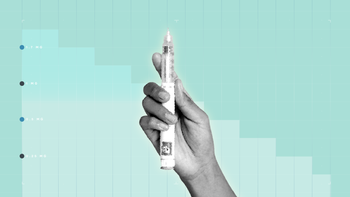
GLP-1 Side Effects: What to Expect with Ozempic, Zepbound, and More
Key takeaways:
Glucagon-like peptide-1 (GLP-1) is a natural gut hormone your body releases after eating. There are medications that mimic its effects, such as semaglutide (Ozempic, Wegovy, Rybelsus) and tirzepatide (Mounjaro, Zepbound).
GLP-1 medications can cause similar side effects. Examples include nausea and vomiting, bloating, and bowel changes like diarrhea and constipation. While rare, pancreatitis and gallbladder problems have been linked to GLP-1s.
Many GLP-1 side effects are temporary. They’re often worse when starting treatment and after your dose is increased. Dietary and lifestyle changes can play a crucial role in managing them to help you stick with treatment.
Table of contents

You may have heard about how effective medications like Ozempic (semaglutide) and Zepbound (tirzepatide) can be. But you may have also come across stories about their side effects. From nausea to potential long-term risks, starting a new treatment can feel overwhelming if you don’t know what to expect.
These medications work by mimicking natural gut hormones — glucagon-like peptide-1 (GLP-1) and, in some cases, glucose-dependent insulinotropic polypeptide (GIP). This unique action makes them powerful tools for managing blood glucose (sugar) and body weight. But it’s also why certain side effects can occur. Here’s what you should know.
GLP-1 side effects list
GLP-1 medications have potent effects on the gastrointestinal (GI) tract and appetite center of the brain. This can contribute to their common side effects, especially nausea. For many people, these side effects improve over time. But in rare cases, serious side effects have also been reported.
Common or mild GLP-1 side effects include:
Nausea and vomiting
Diarrhea
Constipation
Stomach pain
Bloating
Injection site reactions
Increased heart rate
Appetite changes
Weight loss
Indigestion
Heartburn
Dizziness
Fatigue
Hair loss
Low blood glucose (hypoglycemia)
While rare, potentially serious side effects have been linked to GLP-1s, including:
Gallbladder problems, such as gallstones and inflammation
Pancreatitis (inflammation of the pancreas)
Acute (sudden) kidney damage
Gastroparesis
Bowel obstruction (blockage)
Intestinal paralysis (ileus)
Worsening of diabetes-related eye problems
How to save: Treatment with glucagon-like peptide-1 (GLP-1) medications doesn’t have to break the bank. Explore ways you can save on your GLP-1 prescription.
GLP-1 comparison: Ozempic (semaglutide) and Zepbound (tirzepatide) are two medications that work in a similar way. Here’s how GLP-1 medications compare.
Long-term side effects: Some Wegovy (semaglutide) side effects can cause long-term complications. Here’s what you should know about Wegovy’s long-term side effects before you start taking it.
GLP-1 medications also have a boxed warning about a potential risk of thyroid C-cell tumors. A boxed warning is the FDA’s strongest warning for a medication.
Side effects are a common reason why some people stop taking GLP-1 medications. But these practical tips can help you stick with treatment. Below are 10 GLP-1 side effects and how to manage them.
1. Gastrointestinal side effects: Nausea and vomiting, bloating, and bowel changes
GI side effects are the most commonly reported GLP-1 side effects, especially when first starting or increasing your dose. Examples include:
Nausea and vomiting
Bowel changes such as diarrhea, constipation, or both
Bloating
Stomach pain
Read more like this
Explore these related articles, suggested for readers like you.
Most of these side effects are mild and get better over time. In the meantime, here are some tips for managing them:
Eat smaller meals. GLP-1s can make you feel full faster than usual. Avoid filling up too quickly by eating smaller portions throughout the day. It also helps to stop eating once you feel like you’re starting to get full.
Choose gentle foods. Stick to bland, low-fat, and easily digestible foods during the times you’re having nausea, diarrhea, or an upset stomach. Some examples include crackers, bananas, and rice.
Keep hydrated. Drink plenty of water throughout the day to avoid dehydration, especially if you’re vomiting or have diarrhea. Keeping hydrated can also help with constipation.
Avoid triggers. Limit greasy, spicy, or fatty foods, which can worsen symptoms. It’s also a good idea to avoid or limit alcohol and carbonated drinks.
Stay upright after eating. Remain seated or standing for at least 30 minutes after meals to help lessen nausea and heartburn.
Try home remedies. Home remedies, such as ginger, may be helpful for nausea. Anti-gas remedies, such as simethicone (Gas-X) and alpha galactosidase (Beano), may help prevent or relieve bloating.
While rare, GLP-1 medications have been linked to more serious complications that can cause similar side effects. Examples include gastroparesis (stomach paralysis), bowel obstruction, and intestinal paralysis. It’s not clear if GLP-1s directly cause these issues. Tell your healthcare team if your symptoms are severe, getting worse, or not going away.
2. Appetite changes and weight loss
GLP-1 medications are known to reduce appetite, which can result in weight loss. For this reason, several are FDA approved for weight loss, including Wegovy (semaglutide), Zepbound, and Saxenda (liraglutide). While this is an intended effect, some people may not get adequate nutrition because they’re eating less.
Your healthcare team can work with you to come up with a meal plan that meets your specific needs. But here are a few tips to help manage appetite and weight changes during treatment:
Prioritize balanced meals. Be sure to include protein, whole grains, and healthy fats to maintain proper nutrition.
Don’t skip meals. Aim to eat regularly to ensure that your body gets essential nutrients. Try eating smaller meals throughout the day to avoid potential discomfort. If you have diabetes, it’s especially important not to skip meals. Otherwise, your blood glucose could drop too low.
Monitor your weight. Keep track of weight loss and discuss any concerns with your healthcare team.
Listen to your body. Stop eating when you’re full but ensure you consume enough calories to meet your nutritional needs.
3. Injection site reactions
After injecting a GLP-1 medication, you may notice mild reactions at the injection site. This can include redness, swelling, or pain. These reactions are usually temporary and not serious.
Here are a few tips for preventing injection site reactions from GLP-1 medications:
Rotate injection sites. You can inject GLP-1 medications into your abdomen, thigh, or upper arm. But don’t use the exact same spot to inject your dose each time.
Use proper technique. Follow your healthcare team’s instructions or request a refresher if needed.
Use a new needle (if applicable). Some GLP-1 medications come in multi-dose injection pens. Don’t reuse needles — attach a new one each time.Keep the area clean. Wash your hands and clean the injection site with alcohol before injecting. Don’t blow on the area after cleaning it with alcohol to make it dry faster.
Apply a cold compress. Use a cold pack on the area after injecting to minimize swelling or discomfort.
While rare, severe allergic reactions (such as anaphylaxis) are possible with GLP-1 medications. If you develop other symptoms, such as swelling of the face, lips, or tongue, difficulty breathing, or hives, seek emergency medical care.
4. Low blood glucose (hypoglycemia)
GLP-1 medications are unlikely to cause low blood glucose (hypoglycemia) on their own. But this risk goes up when they’re combined with other diabetes medications, such as insulin or sulfonylureas. Watch for symptoms such as dizziness, shakiness, and sweating.
Some tips to manage hypoglycemia and lower your risk include:
Keep fast-acting glucose handy. Carry glucose tablets, juice boxes, or hard candy in case your blood glucose drops too low. Hypoglycemia can become life-threatening if it’s left untreated.
Avoid skipping meals. Regular meals and snacks help maintain steady blood glucose levels. Be sure to also fuel up properly before and after workouts.
Work with your healthcare team. If you’re frequently experiencing episodes of hypoglycemia, your prescriber may adjust your medication regimen.
Monitor your glucose levels. Regularly check your levels to catch drops early. Confirm low readings with a glucometer if you wear a continuous glucose monitor.
If you have severe hypoglycemia (glucose below 55 mg/dl), someone may need to administer glucagon and call 911. Glucagon is a medication that helps bring up blood glucose levels quickly.
5. Cosmetic changes, such as ‘Ozempic face’ and hair loss
Some people report noticeable cosmetic changes after starting GLP-1 medications. These effects, often linked to rapid or significant weight loss, include less fullness in the face and hair loss.
Ozempic face
The term “Ozempic face” describes changes in facial appearance, such as sagging or wrinkles, that some people experience after significant weight loss. This isn’t from the medication itself, but reduced fat stored under the skin of the face. A few ways to manage facial changes include:
Focus on hydration. Drink plenty of water and use moisturizing skincare products to improve skin elasticity.
Consult a dermatologist. Non-invasive cosmetic treatments, such as fillers or Botox (onabotulinumtoxinA), may help restore fullness and smooth wrinkles.
Pace weight loss. Aim for gradual weight loss to give your skin more time to adjust. In this case, your prescriber may recommend increasing your dose more slowly.
Hair loss
Hair loss or thinning has also been reported by some people taking GLP-1 medications. This is also likely linked to rapid weight loss, which can temporarily disrupt the hair growth cycle. Not getting enough vitamins and minerals can also contribute to this side effect. If you notice hair loss or thinning, here are a few things you can do:
Eat a balanced diet. Ensure you’re getting enough protein and other essential nutrients to support healthy hair.
Give it time. Hair loss associated with GLP-1 medications is usually temporary. You may notice some improvement within a few months after your weight stabilizes.
Be gentle with your hair. Give your hair a break from chemical treatments, such as coloring, and avoid heat styling or tight hairstyles. This can help reduce stress on your hair follicles. Opt for gentle shampoos and hair products to minimize damage.
Talk to your healthcare team. They can assess whether underlying conditions or other medications may be contributing to hair loss.
6. Increased heart rate
GLP-1 medications may cause a slight increase in resting heart rate for some people. This isn’t usually harmful. In fact, several GLP-1s have heart-related benefits. This includes people with atrial fibrillation (a type of irregular heartbeat). But if you have a heart condition, it’s a good idea to monitor for symptoms such as palpitations or chest discomfort.
Here are a few tips for managing an increased heart rate from GLP-1s:
Stay active. Engaging in moderate exercise can help improve your overall heart health. Regular workouts can also help you get the most out of your GLP-1 medication.
Limit stimulants and other substances. Try to reduce your intake of caffeine, other stimulants, and alcohol, since they may increase your heart rate even more.
Monitor regularly. Check your resting heart rate periodically. Report significant changes to your healthcare team. They may decide to adjust your dose or have you stop the medication.
7. Gallbladder issues: Gallstones and inflammation
GLP-1 medications have been linked to an increased risk of gallbladder issues, such as gallstones and an inflamed gallbladder. It’s not fully understood why this happens. But it may be due to rapid weight loss or indirect effects on the gallbladder. While uncommon, gallbladder problems may be more likely with higher doses and longer durations of use.
Gallbladder issues can become life-threatening if they’re left untreated. Go to the ER if you experience symptoms such as persistent upper-right abdominal pain, nausea and vomiting, and jaundice (yellowing of the skin or eyes).
8. Pancreatitis
While rare, GLP-1 medications have been linked to pancreatitis, a serious inflammation of the pancreas. But it’s not known if these medications directly cause this side effect, or if it’s due to something else.
Even so, it’s a good idea to familiarize yourself with the symptoms of pancreatitis in case it develops. These include severe, persistent abdominal pain that may radiate to the back, nausea and vomiting, and jaundice. If left untreated, pancreatitis can be life-threatening. So it’s best to go to the ER if these symptoms occur.
If you have a history of pancreatitis, make sure your healthcare team is aware. They may prescribe a different medication for you.
9. Acute kidney damage
GLP-1 medications have been shown to have beneficial effects on the kidneys. While uncommon, acute kidney damage has also been reported. Most cases have been in people with severe side effects that lead to dehydration. Watch for symptoms of kidney damage such as decreased urination or swelling in the legs.
Here are a few tips to help lower your risk of kidney damage:
Stay hydrated. Drink plenty of fluids, especially if you have nausea, vomiting, and diarrhea. This helps replace fluids you’ve lost to prevent dehydration.
Maintain regular checkups. Your healthcare team may want to monitor your kidney health during treatment. Be sure to tell them if you’ve been experiencing persistent or severe side effects.
Limit medications that cause kidney damage. Nonsteroidal anti-inflammatory drugs (NSAIDs), such as ibuprofen (Motrin, Advil), can be hard on the kidneys. It may be a good idea to avoid or limit NSAID use, especially if you’re dehydrated.
10. Thyroid C-cell tumors
All GLP-1 medications carry a boxed warning for the potential risk of thyroid C-cell tumors, based on animal studies. This risk hasn’t been confirmed in people. But those with a personal or family history of medullary thyroid cancer should avoid these medications. This is also the case if you have an inherited condition called multiple endocrine neoplasia type 2.
Here are a few ways to manage this risk:
Discuss your history. Share any personal or family history of thyroid conditions with your healthcare team before starting a GLP-1 medication.
Watch for symptoms. Report any lumps, swelling, or changes in your neck to your prescriber.
Follow up regularly. Your healthcare team may want to monitor your thyroid health during treatment.
The bottom line
Common side effects of glucagon-like peptide-1 (GLP-1) medications include nausea and vomiting, stomach pain, and diarrhea. Constipation, appetite changes, and injection site reactions have also been reported. Many GLP-1 side effects are temporary and improve over time.
While less common, serious side effects have been linked to GLP-1 medications. Examples include pancreatitis and gallbladder problems, which require medical attention. Talk to your healthcare team if you have any questions or concerns about GLP-1 side effects.
Why trust our experts?


References
Begum, F., et al. (2024). Semaglutide-associated kidney injury. Clinical Kidney Journal.
Gether, I. M., et al. (2018). New avenues in the regulation of gallbladder motility—implications for the use of glucagon-like peptide–derived drugs. The Journal of Clinical Endocrinology & Metabolism.
He, L., et al. (2022). Association of glucagon-like peptide-1 receptor agonist use with risk of gallbladder and biliary diseases. JAMA Internal Medicine.
Lorenz, M., et al. (2017). Differential effects of glucagon-like peptide-1 receptor agonists on heart rate. Cardiovascular Diabetology.
MedlinePlus. (2019). Glucagon injection.
Saglietto, A., et al. (2024). Glucagon-like peptide-1 receptor agonist semaglutide reduces atrial fibrillation incidence: A systematic review and meta-analysis. European Journal of Clinical Investigation.
Sikirica, M. V., et al. (2017). Reasons for discontinuation of GLP1 receptor agonists: Data from a real-world cross-sectional survey of physicians and their patients with Type 2 diabetes. Diabetes, Metabolic Syndrome and Obesity.
Sodhi, M., et al. (2023). Risk of gastrointestinal adverse events associated with glucagon-like peptide-1 receptor agonists for weight loss. JAMA.
Target. (2024). Alpha galactosidase capsule [package insert]. DailyMed.
Willson, A. (2024). Facial fat: The good, the bad and the confusing. American Society of Plastic Surgeons.





























